Hello Spark Zen readers! As I type this post, it’s 5:30 AM on Saturday morning. Our last morning in the beautiful state of Maine. I almost typed, “mind.”
“Maine mind.”
Ah, euphony and alliteration!
Maine mind is zazen mind in motion: Attentive, peaceful, and wonder-filled. Of course, you don’t have to travel to Maine to experience these attributes of mind. We can cultivate them whether we’re meditating, hiking, writing, oh, and planning for vacation.
The week or two leading up to vacation can often be hectic as we try to accomplish as many tasks as possible. The tasks that were not either urgent or important enough to tackle right away are the ones that crowd my to-do list and demand my attention before I leave. In my five-year tenure in 9-to-5 corporate land, I heard the adage “work expands to the time allotted.” And I find this to be true, whether I’m writing a Spark Zen post, preparing for a Dharma talk, or completing an administrative task. If there’s a whole lotta time to do something—if there’s no due date, no parameters, no expectations—the mind meanders.
However, as soon as I’ve bought the plane tickets and booked the hotel, I shift into “pre-vacation mind.” I become intently focused on prioritizing and accomplishing the tasks on my to-do list. If we approach each task with wholehearted effort, and drop multi-tasking mind (which is a myth, BTW), we can experience an externally oriented samadhi—the “one-pointedness” or “single-mindedness” of a concentrated mind.
David Chadwick, an early student and the main biographer of Shunryu Suzuki Roshi, once asked him “What is Nirvana?” He replied: “Seeing one thing through to the end.”
For me, the due date of getting on a plane for vacation provided a helpful container for me. What do I mean by container? Good question. When I first started practicing Zen in 2001, the teacher at Austin Zen Center would use this word quite a bit. For example, I heard the phrases “the container of zazen” and “the container of the monastic schedule.”
I figured everyone in the room knew what the teacher meant by “container” because no one ever inquired about it. So I just decided to keep my ignorance to myself. I imagined there was some sort of official Zen Tupperware that people carried around in which they packed both their lunch and their mind.
For those of you who are mystified by these phrases like I was, I’ll demystify. Many people define “freedom” as the ability to do what they want, when they want, and how they want. Consequences be damned, well at least ignored. I call this “teenager mind”: lacking discipline, focus, and responsibility. The exact opposite of “monk mind.”
When we can do whatever we want, whether that’s just during an hour or day or a week, it’s difficult to notice when the mind is rollicking in the land o’ distractions. It’s nearly impossible to “see one thing through to the end,” when our minds are not focused on what we’re doing in the present moment; whether that’s chopping carrots, scheduling a meeting, or writing an essay.
Fortunately for us, it’s possible to cultivate mindfulness or sati no matter the activity we’re engaged in. And, even more fortunate for us, is that the Buddha tells us how to do this in one of his most comprehensive teachings: “The Four Foundations of Mindfulness” or The Satipatthana Sutta. The Buddha offers detailed instruction on contemplating how we humans experience our internal and external worlds. These foundations are: the body, sensations, mind, and phenomena. Contemplating these foundations begins with the physical and progresses to the more subtle experiences of sensations, thoughts, and mental qualities.
As the Venerable Anālayo writes in Satipatthana Meditation: A Practice Guide, the key aspect of sati is being aware of what’s happening in the nano-moments of the now. Although sati is an intrinsic faculty of human consciousness, it “is not a given of any experience, but rather requires intentional cultivation.” This is a vital point. Paying attention in the here-and-now takes perseverance, viriya—one of the Five Faculties.
While being active I usually have to stop what I’m doing to connect and align with the embodied awareness of what’s arising in the heart-body-mind. However, it’s not always possible or advisable to stop amid an activity to place the mind’s attention on what’s happening now. Sometimes being distracted leads to forgetting an appointment or emailing the wrong person. However, being distracted when you’re chopping vegetables or hiking can lead to physical injury.
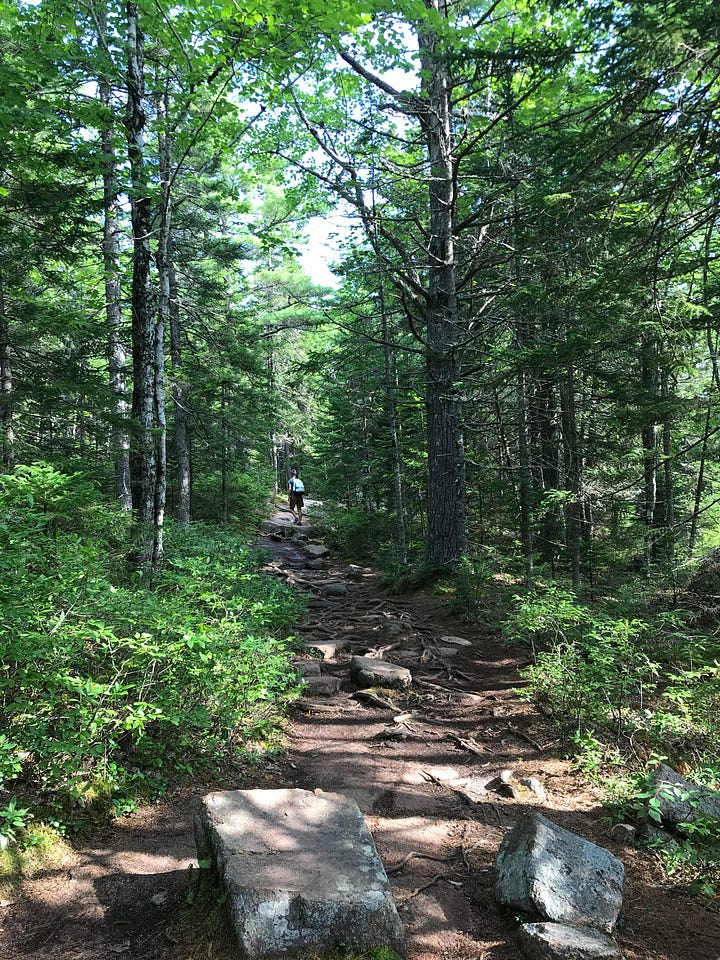
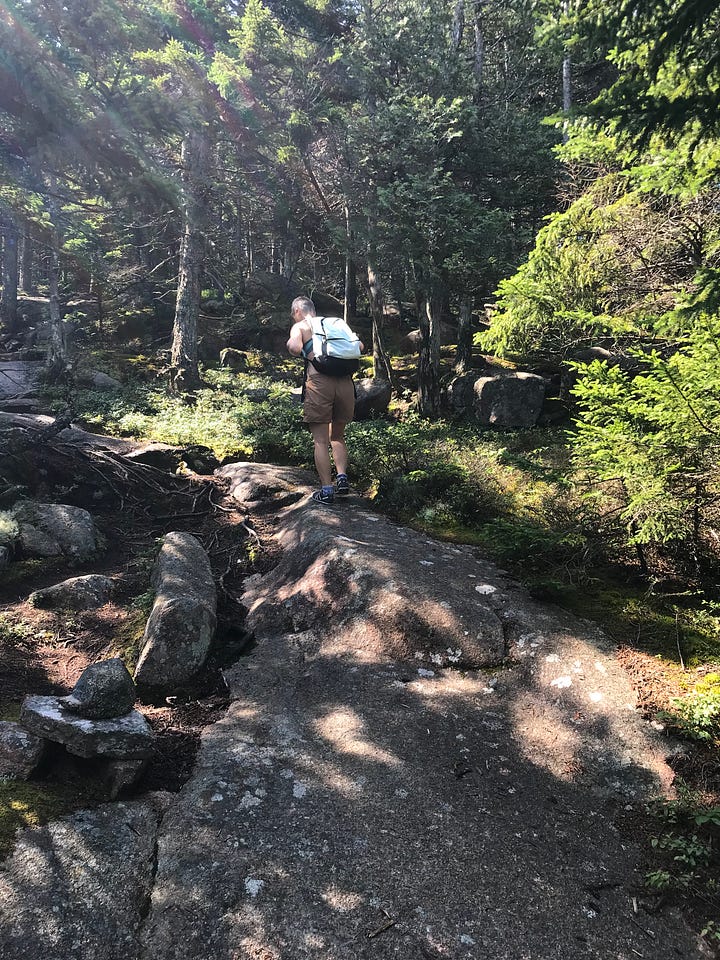
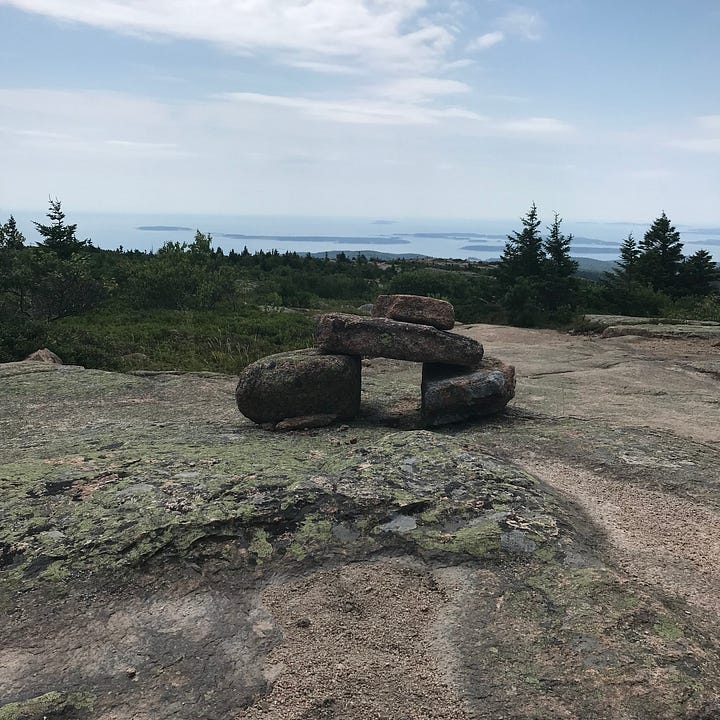
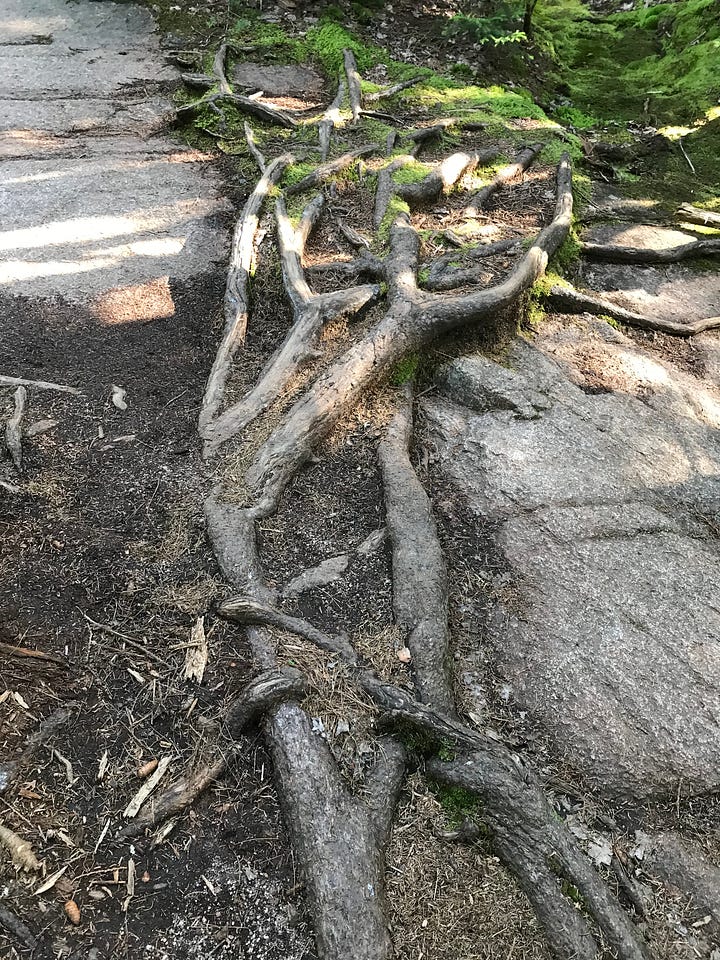
During this vacation to Maine, the container for this body-mind was the roots, rocks, and ridges of the many hiking trails we explored in Acadia National Park. 7 trails, 30 miles, in 3.5 days, to be exact. Those stats might make it sound like I’m an avid hiker. Wrong! I’m married to one, so I’m more like an avid—TBH, sometimes a reluctant—appendage. My spouse Tanya and I view mountains, gorges, and forests through contrary vantage points: where she sees adventure and challenge, I see death and disaster. Fortunately, her perspective reflected the reality of our splendid time in Acadia.
However, I did hurt myself on day two, at the beginning of the Cadillac Mountain South Ridge Trail—a 6.7 mile hike. With its summit at 1,530 feet, Cadillac Mountain is the highest peak on the Eastern Seaboard of the USA. (Who knew?) Since this is the USA, and cars rule even in National Parks, you can buy a pass to drive up the mountain during the day or to watch the sunrise. Tanya would’ve filed for divorce had I suggested we drive to the summit!
“Roots and rocks,” is how the helpful ranger in the visitor’s center described this trail. And he was accurate. Within the first 10 minutes of walking, I pulled my right calf muscle. How? By not paying attention! My mind was not aligned with what the body was doing. I confess that I had just finished taking a photograph to accompany my Spark Zen posts when the incident happened.
I was placing the phone in my back pocket when I stepped on a raised root. Instead of pushing off with the ball of my foot, I mindlessly pushed down with my heel. Nothing but air and pain. I cursed, and loud enough that Tanya, who’s usually ahead of me, turned around with a panicked look on her face.
As I alternately hobbled, hopped, and limped toward a boulder to sit on, my calf muscle screamed louder and louder. Nothing brings the mind’s attention to a focal point like intense physical pain. If I were a believer in a deity, which I’m decidedly not, I would’ve viewed this as divine comeuppance for being a preacher of mindfulness and failing miserably as a practitioner of it.
After my body-mind calmed down a wee bit through my concerted effort of following my inhales and exhales, Tanya gently massaged my calf for a few minutes. Fortunately for me she’s a fantastic and intuitive Rolfer (a structural integrationist). Even still it was a bad sprain, and we both thought this was the end of our hike. I’m not a person who suffers silently, but I did my darnedest to contain the “poor-me” mind by tethering it to the exhale and silently releasing it like an invisible ghost.
As I continued to remain seated on the boulder, I could see the disappointment on Tanya’s face, whose mien is usually much more stoic than mine. Okay, mine’s not stoic at all. She unconvincingly said, “It’s okay if you want to turn around.” My turning around meant that she would have to turn around because she would never leave me. We had only walked for about a quarter of a mile. So we had another 6.5 miles to hike roundtrip. To say that she ardently wanted to keep hiking would be an understatement.
Tanya bleeds wild.
As I sat on the large boulder with my right leg extended, my ears tuned in to the sound of an unfamiliar birdsong. Although I could not see the feathered singer, her melody floated through the sun-dappled forest, and I closed my eyes and breathed the birdsong into my heart.




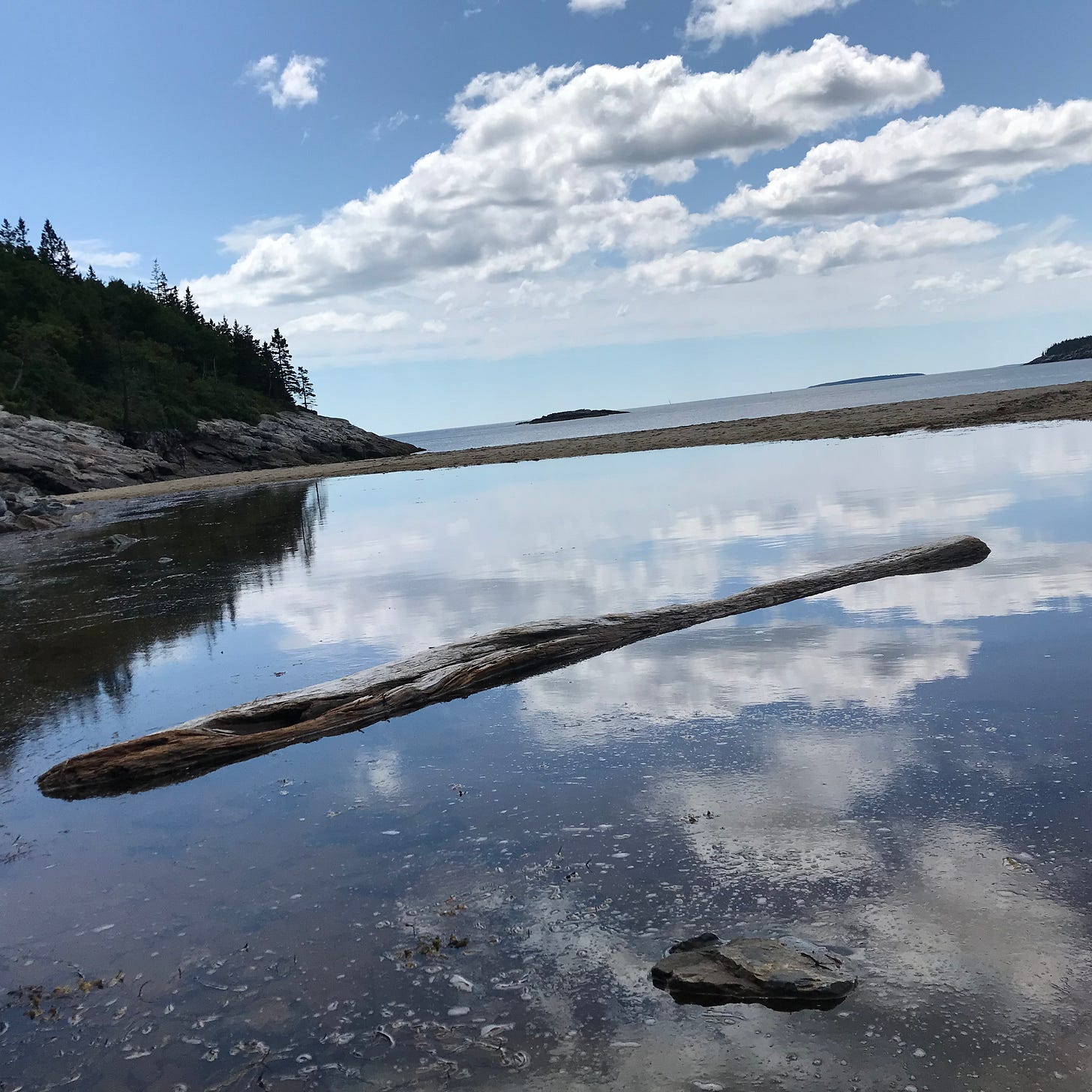
Sorry, anymore, at my age, so am getting vicarious pleasure from your adventures!
Heather, I’m not hiking an